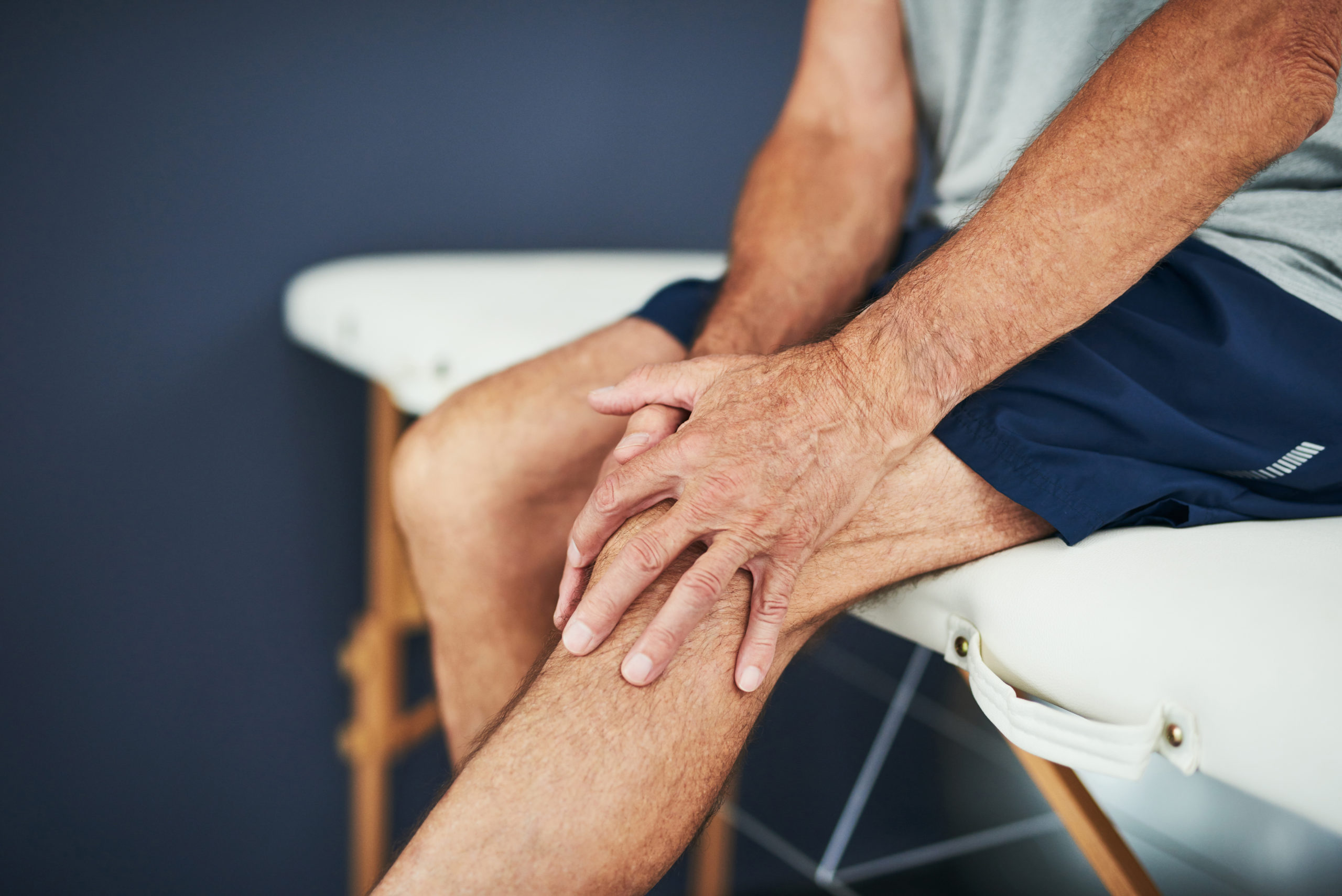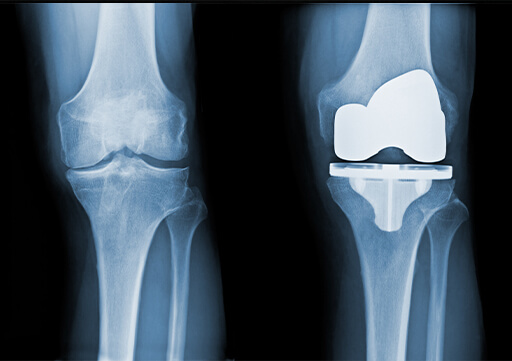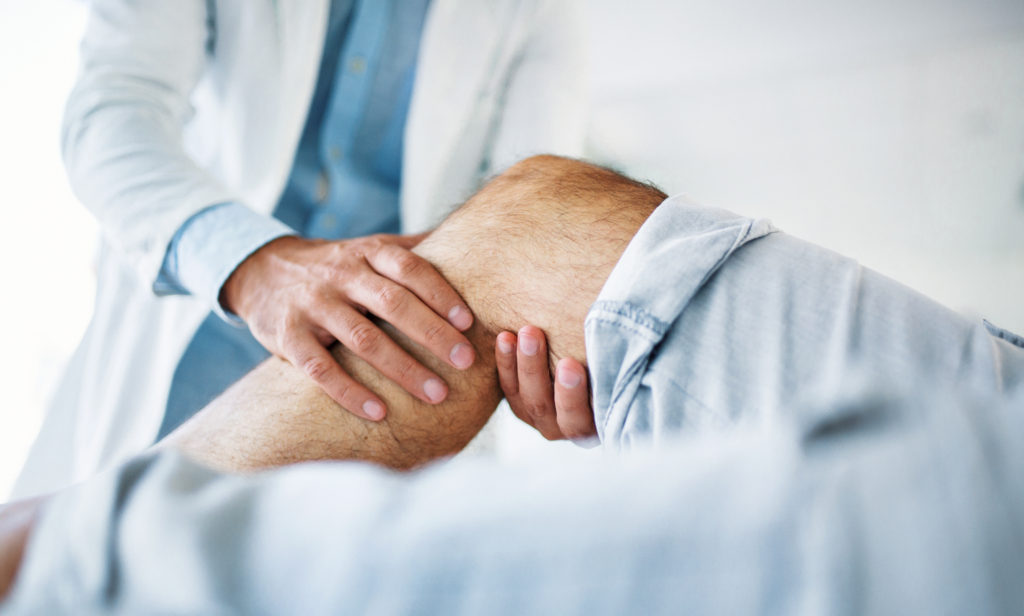Knee Osteoarthritis (OA) is the most common type of arthritis of the knee. It is frequently diagnosed as ‘wear and tear‘ or ‘degeneration‘ of the knee joint
Most of the time when we discuss Knee Arthritis we are referring to Knee Osteoarthritis. The terms are often used interchangeably and refer to the same disease
Knee Arthritis is inflammation of the knee joint. The symptoms are pain, swelling and stiffness.
With time the different structures of the knee joint become damaged. The cartilage responsible for smooth movement and function of the knee starts to degenerate (breakdown). The synovial fluid production which lubricates the knee joint also starts to become impaired.
This, combined with a loss of cartilage, causes loss of elasticity and flexibility of the knee joint which develops a more rigid feel. The Joint feels stiff and restricted in straightening or bending.
The shape of the knee often changes and small bony growths called osteophytes may develop.
The pain gradually gets worse where routine activities like coming down a flight of stairs or walking becomes increasingly difficult. It may also interfere with the ability to do physical work and thus is a major cause of pain and disability.
The stages of Knee Osteoarthritis are shown in the video below
Knee Arthritis: 4 stages of Osteoarthritis
Stage 1: Very minor wear and tear and bony spurs (osteophytes) around the knee joint. Relatively Pain free. Supplements such as glucosamine, chondroitin and turmeric are recommended at this stage along with healthy lifestyle incorporating exercise and weight reduction
Stage 2: Mild. This when the first symptoms of joint pain start to become apparent. An x-ray may be taken which shows more osteophytes. The knee may feel more painful and stiff after rest or exercise. At this stage knee joint strengthening exercises may increase knee joint stability and reduce the rate of progression of the Arthritis
Stage 3: Moderate. Frequent pain and inflammation of the knee when walking, kneeling or exercising. An X-ray will show a narrowed joint space and there are more osteophytes.
Stage 4: Advanced. Patients with Stage 4 OA of the knee have what we call ‘end stage’ or ‘bone on bone’ arthritis. They experience great pain and discomfort when moving. The cartilage in the knee has frequently worn down to the point that the bones of the knee are contacting each other causing severe pain. Often at this stage the patient may benefit from a knee replacement.
Who gets Osteoarthritis of the Knee?
It is the most common type of Arthritis. The chance of developing Osteoarthritis rises after age 45. According to the Arthritis Research group, nearly 9 million people in the U.K have osteoarthritis, with the knee being one of the most commonly affected joints. X-ray studies have shown that at least 50% of people over the age of 65 have evidence of osteoarthritis on imaging
Causes of Knee Osteoarthritis

The most common cause of Knee Osteoarthritis is age. Most people will eventually develop some form of osteoarthritis as it is a natural degenerative process as we age. There are however, several important factors which can increase the risk of developing osteoarthritis:
- Age: The elasticity of cartilage and its ability to repair itself reduces with age. It most commonly affects patients over the age of 50. Often younger ages can be affected
- Previous Joint Injury/Trauma: This can cause damage to the cartilage on the joint surface and commonly result in premature osteoarthritis in the joint. Ligament injuries such as Anterior Cruciate Ligament and Meniscal tears can also predispose to earlier osteoarthritis through internal damage to the joint.
- Obesity: An increase in weight increases the stress on the knee joint. For every one pound of weight gain, the knee takes an additional 3-4 pounds in additional stress.
- Genetics: Frequently there is a family history that may predispose a person to Osteoarthritis earlier. Genetic testing has found certain mutations linked to the development of Osteoarthritis
- Gender: Women over the age of 55 are more likely to develop osteoarthritis in the knee than men
- Occupation: Different jobs can place different stresses on the knee joint. People who are engaged in work that involves greater loads on the knees may develop knee osteoarthritis
- Sports: Certain Sports or activities may cause a person to develop osteoarthritis because of the unfavourable stress placed on the knee joint.
- Illness/Infection: Certain infections like Septic Arthritis or Infectious diseases may cause premature knee osteoarthritis. People with metabolic conditions such as hemochromatosis (where the body absorbs too much iron) may also develop knee osteoarthritis
What are the symptoms of Knee Osteoarthritis
Symptoms of knee osteoarthritis are:
- Knee Pain increasing with prolonged activity but better with rest. Increasing and more consistent pain with activity
- Swelling of the knee especially after activity. This may decrease with rest
- Joint Locking/instability: A feeling that the knee may give way
- Warm/red joint during flare ups of osteoarthritis especially after activity or in the winter
- Stiffness in the joint on standing after you have been sitting down for a while. This along with Pain is the most common symptom of knee osteoarthritis. Morning stiffness lasting less than 30 minutes after beginning daily activities. If Morning Stiffness lasts up to an hour, this may be due to Inflammatory Arthritis and a blood test at your doctor is advised
- Pain on walking up or down a flight of stairs
- Pain at night which disturbs sleep
- Reduced range of motion of the knee at extremes such as flexion and extension (bending or straightening the knee becomes more difficult)
Diagnosing Knee Osteoarthritis
The diagnosis of Knee Osteoarthritis is frequently made from a history and examination. Quite frequently the diagnosis can be made with reasonable certainty without having to do further investigations. In mild to moderate cases or where the diagnosis is uncertain an initial investigation would be x-ray whilst weight bearing. This is more accurate that an x-ray taken with the patient supine (lying down)
X-ray findings may be reduced space between the bones. There is also subchondral sclerosis, periarticular cysts, and bone spurs called osteophytes
In cases of advanced knee osteoarthritis, both bones may be rubbing on each other frequently termed ‘bone on bone’ and produce painful bone spurs

Treatment of Knee Osteoarthritis
Initial Treatments are based on symptomatic relief:
- Analgesics: NSAIDS (Non Steroid Anti inflammatory Drugs) medication such as Naproxen or Ibuprofen tablets or Ibuprofen Gel. This is often combined with paracetamol.
- Capsaicin cream: This may be prescribed if topical NSAIDS have not been effective in easing your pain. It works by blocking nerves that are sensitive to pain in the knee joint
- Physiotherapy Exercises: To strengthen some of the muscles around the knee joint and ‘off load’ some of the stress being placed on the knee joint. Exercises also help the mobility of the knee joint.
- Activity Modification: If there is an activity which is highlighted as avoidable and could be making the problem worse
- ICE/heat pads: May temporarily relieve stiffness and aching
- Knee supports: Can often control swelling that occurs with activity as well as providing mechanical support when the knee feel like it is ‘giving way’
- Shoe insoles/orthotics: If identified as potential issue with feet with uneven load distribution through the knee. This can lead to osteoarthritis in the medial or lateral compartment of the knee. Early identification and correct insoles may prevent this
- Swimming: Help maintain muscle pain whilst reducing wear and tear on the joint
- Cortisone Injections: Helpful in Pain relief. They contain an anti inflammatory painkiller which helps provide pain relief especially when oral analgesia or other measures are not providing satisfactory pain relief
- Viscosupplementation: If you have tried all the other non surgical treatment methods and the pain continues to trouble you, Viscosupplementation may help. A gel-like fluid called hyaluronic acid is injected into the knee joint. This is a naturally occurring substance found in the synovial fluid which surrounds the knee joint. It acts as a joint lubricant to enable the smooth movement of bones over one another.
- Platelet Rich Plasma (PRP): PRP is the product derived when blood taken from a patient is processed to obtain a preparation rich in platelets and plasma. The preparation is rich in growth factors as well as many thousand of other substances.
Do you feel you have Knee Osteoarthritis? To book in at the MyMSK Clinic for an assessment and prompt treatment Click here
Whether it is a sporting injury that you just cannot shake, or a symptom of a chronic condition such as arthritis, knee pain can be a severely debilitating problem. Of all your joints your knees are particularly vulnerable – every time you take a step the tibia and fibula, the bones of your lower leg, impact with your femur or thigh bone. Naturally, they are designed to do this, but if something goes wrong this constant and unavoidable pounding can quickly exacerbate the problem. Sometimes an ibuprofen is enough to relieve the pain. Sometimes you need something more effective.
Cortisone Injections for Knee Pain Relief
At MyMSK Clinic we can help. Cortisone is a form of the natural hormone cortisol. When injected into a painful joint it can relieve pain by acting as an anti inflammatory within the joint. This causes your immune system to cause less inflammation in the joint and this in turn reduces the pain. Because of its calming effect on the immune system, cortisone injections are particularly useful in the treatment of degenerative diseases such as arthritis.
Cortisone injections are commonly used to relieve knee pain. We offer a through and complete assessment and treatment of cortisone injections for long-lasting knee pain relief. So do not accept that painful joints are “just a sign of getting older” or “something you have to live with.” Talk to MyMSK Clinic about a cortisone injection. Knee pain can be effectively controlled using this simple, non-surgical treatment and the beneficial effects can last for many months. Most people do not experience side-effects after receiving a cortisone injection in the knee, although some people may experience redness or flushing of the face for a day or two after the procedure.
A private cortisone injection in the UK can be more affordable than you might think. If you are experiencing chronic joint pain that is having a negative effect on the way you live your life you owe it to yourself to consider a cortisone injection. Knee pain can be relieved with a single treatment for just £225.00, including the initial consultation.
Don’t wait. Call MyMSK Clinic now and discover a world where walking and running no longer hurt. Rediscover the freedom to move with MyMSK Clinic.





